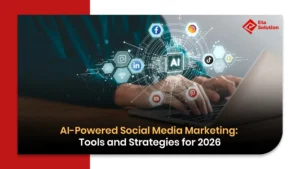
How Content Marketing Helps Businesses Grow | Boost Leads & Brand Awareness
Content marketing is often misunderstood by people who believe it is solely about writing blogs or posting on LinkedIn. However, it is essentially the invisible sales team that is working around the clock. Every piece of content, a video, or a podcast that includes your brand’s voice is a part of the selling process, but they do it quietly and gradually, even when your sales team is not around.
Moreover, the amazing thing to say is this: According to stats from Demand Metric, content marketing brings in thrice the leads as traditional marketing and is 62% less expensive. Still, most businesses remain unaware of the strategic character of content marketing. So, let’s unpack the reality of content marketing as the actual business growth driver and the reason why it has become a critical resource of successful brands.
1. Content Marketing Definition
Content marketing is not a numbers game. It’s the art of crafting brand stories that resonate with the audience. The process involves the content creation and distribution that is valuable, relevant, and consistent for a defined target audience, with the intention of delivering the desired customer action that is profitable.
This method of online marketing is not in line with the disruptive nature of outbound advertising but rather matches the philosophy of inbound marketing, where the audience willingly engages with a brand because of the value it receives in the form of insights, education, or entertainment.
2. Content Marketing Significance for Business
Businesses gain a tangible impact when they put their money into content. Research conducted by HubSpot shows that companies that decide to focus on content marketing are 13 times more likely to generate positive ROI results.
Content is not just about getting digitally visible. An effective content management plan can elevate the performance of the entire customer journey from the very first touch to conversion, thus being a major source of growth for both B2B and B2C brands.
Thought leadership content, in B2B, becomes a trust builder and a credibility marker.
Conversely, storytelling in a B2C context leads to the creation of emotional connections that are eventually translated into customer loyalty.
3. Content Marketing as a Means of Brand Awareness
The story of brands like HubSpot, Mailchimp, or Notion could serve as great examples of how not their aggressive advertising, but their constant, high-quality content production was the major factor that made them authority figures, which would be their takeaway.
Such a brand that has been communicating with the target audience via different channels will be considered the most competent in the field as a result. It is the way of brand awareness, which is less flashy but still more effective and silent.
On the basis of the Content Marketing Institute report, 80% of buyers prefer product information through content rather than ads.
4. Content’s Importance in Growing Organic Traffic
Organic search is one of the most essential components of digital marketing. If you want customers to be in your pipeline without paid media, you need to be producing blogs, videos, and resources that are consistently SEO-optimized.
Some of the factors that will set the good from the average SEO content are as follows:
- Intent Matching: Finding out the true requirement of the user to learn.
- Topic Clusters: Grouping the subjects around the main theme to enhance the authority signal to Google.
- Data Integration: Filling the content with the most recent statistics and studies that support authoritativeness and freshness.
Not only does this method bring visitors to the site, but it also attracts the right visitor group who are already interested in your product or service.
5. Lead Generation Through Content Marketing
The creation of leads is not a side effect of large numbers. It is rather a result of value.
One way to get users to willingly part with their contact details, which then serve as effective signals of interest, is to create resources like eBooks, guides, or webinars that target certain pain points.
For instance, the “Creative Trends” report by Adobe leads several thousand qualified leads annually as it provides unique trend insights to marketers that they cannot get from other sources.
And that is the real and strategic content marketing ROI, not only in terms of clicks but also in terms of dialogues.
6. Content Marketing and Customer Engagement
Engaging customers is not only about likes or comments. It represents a value exchange on a continuous basis.
Consumers Don’t Only Buy, They Engage. Deep Engagement with Brands through Content Marketing. As per Sprout Social, 70% of consumers believe that they get more connected to brands that create meaningful content.
Furthermore, one can use such interactive elements as polls, experts’ Q&A, and user-generated stories for introducing and engaging more consumers. These elements not only add engagement depth and loyalty to your audience but also make them not passive readers but active participants.
7. Content Marketing Role in SEO
Seo and content marketing have a strong connection. Even the most perfect SEO techniques will not succeed if there is no quality content.
At present, search engines give priority to topic authority, engagement signals, and content freshness. As a result, the secret of getting SEO success for a long time is continuous, professional-driven publishing.
To cut a long story short, SEO content today is not about keywords but rather about the context, depth, and credibility of the content.
8. Types of Content Marketing
The truth is that content doesn’t fit all. A smart content strategy merges multiple formats to accommodate different audience preferences and stages of the funnel.
- Blogs: Are the means of building up authority and driving search visibility.
- Videos: The one most suitable for emotional connection and storytelling.
- Infographics: The one that makes complex data easy to understand.
- Podcasts: Are the perfect media for thought leadership and community building.
- Case studies: Show the impact of the solution provided and thus, gain trust.
Every kind of content has a particular function in marketing campaigns.

9. Developing a Content Marketing Strategy
Transparency is the foremost feature of a strong strategy:
- Identify the demographic, psychographic, and goals of the target audience to come up with customer personas.
- Goals should be defined in such a way that the rise of brand awareness, Lead generation, or customer engagement can be quantitatively measured.
- Correlate the material to the consumer’s recognition, reflection, and selection phases of the buying journey.
- Be clever in using social media, e-mails, and specialized interest groups for your distribution.
According to CoSchedule’s annual report, brands using documented strategies outperform brands with no recorded strategies by 60% when it comes to marketing ROI.
10. Best Content Marketing Services for Business Growth
There are companies that can not set up a completely content staff inside the company, but they can take advantage of the best content marketing services to fill in the gap. They have the expertise in storytelling, SEO, design, and analytics, exactly the formula one needs to be able to scale without compromising quality.
Furthermore, digital marketing agencies that specialize in this field of mastery understand perfectly well how to integrate creativity with data. With the correct partner, you can extend the impact of your content, improve your content strategy, and be sure that each play supports your larger business growth goals.
11. Measuring ROI of Content Marketing
One of the most significant ways to achieve content marketing success is not only about the traffic of a website. It is about achieving the desired goals. Some of the metrics are:
- Conversion rates from blogs or gated assets
- Lead quality and source attribution
- Engagement time and bounce rates
- Backlink growth and domain authority
Platforms such as Google Analytics 4 and HubSpot facilitate the direct linking of content to revenue; thus, marketers can assign return on marketing investment with accuracy.
12. Personalization and Targeting in Content Marketing
According to Epsilon’s data, tailoring content leads to around 80% more conversion rates.
Using smart analytics and AI-powered tools, companies can segment customers based on their behavior, location, or buying stage. To accelerate the buying process, brands can implement personalized suggestions, interactive emails, or tailored landing pages as means of maintaining their potential customers’ attention.
Nowadays, it is not about generating a higher volume of content, but rather about creating the most appropriate content for the most suitable person.
13. Common Content Marketing Mistakes to Avoid
Several errors that are common in content marketing, but even proficient marketers make such mistakes:
- No purpose in publishing: Every article or post must have a direct or indirect connection to a business objective.
- Working as if content distribution is not important: Content performing well will still not have the desired impact if nobody can access it.
- Not caring for content updates: The presence of obsolete-themed articles may lower the site’s integrity and also search rankings.
- Not doing measurement: There is no room for upgrading if data is not available.
Marketing efforts can become effective and scalable to the extent that mistakes are avoided.
14. Future Trends in Content Marketing
Some of the aspects of next-generation content consist of AI-led content production, an increased emphasis on first-party data, and richer experiences such as augmented reality and interactive videos.
On the flip side, the winners will be the brands that are advanced in technology, yet human, i.e., the brands that can engender knowledge, empathy, and creativity.
Moreover, the future of content, as Neil Patel and Ann Handley, among other industry leaders, foresee, is not merely going to be technology-driven automation but will be authenticity that is scaled by technology.
Closing Take
Content marketing has transformed from being just another tactic to the essence of today’s business storytelling.
It propels customer engagement beyond a period of a campaign, in addition to bringing in leads and building brand equity.
Considering your next quarter strategy, you should ask yourself the following question
Is content being handled as just another expense under your budget, or as the lifeblood of your brand?
In this era, content is not assisting your business; rather, it is your business.
High-quality, keyword-optimized content helps websites rank better on search engines, increase organic traffic, and gain authority in the niche.
Examples include blog posts addressing customer pain points, case studies showcasing results, educational videos, and email newsletters that build long-term relationships.
Typically, it takes 3 to 6 months to start seeing measurable results such as improved traffic, engagement, and lead generation, depending on consistency and strategy.
Small businesses can use content marketing to establish credibility, reach local audiences, and compete with larger brands through valuable, SEO-optimized content without high advertising costs.
By educating potential customers and nurturing them through the buyer journey, content marketing builds trust and confidence, leading to higher conversion rates and sales growth.

What started as a passion for marketing years ago turned into a purposeful journey of helping businesses communicate in a way that truly connects. I’m Heta Dave, the Founder & CEO of Eta Marketing Solution! With a sharp focus on strategy and human-first marketing, I closely work with brands to help them stand out of the crowd and create something that lasts, not just in visibility, but in impact!

Industrial Product Marketing with LinkedIn & Paid Ads

Top Digital Marketing Strategies for Industrial Products in 2026

B2B Product Launch Strategies: From Pre-Launch to Go-To-Market

